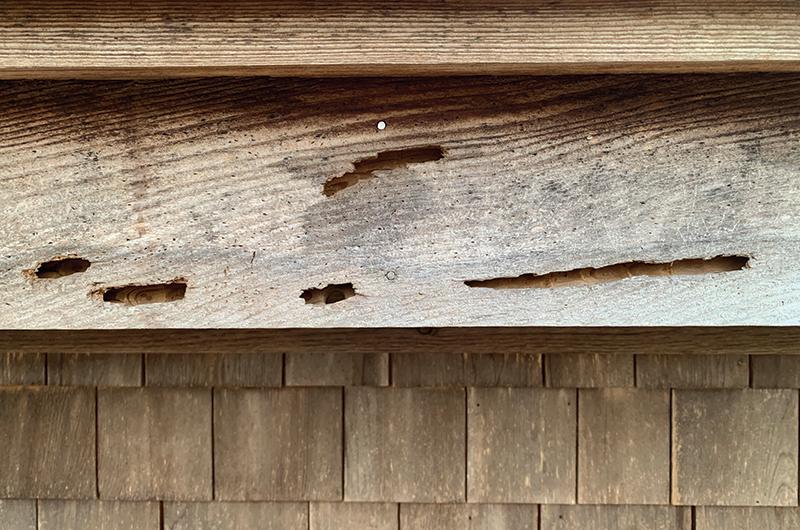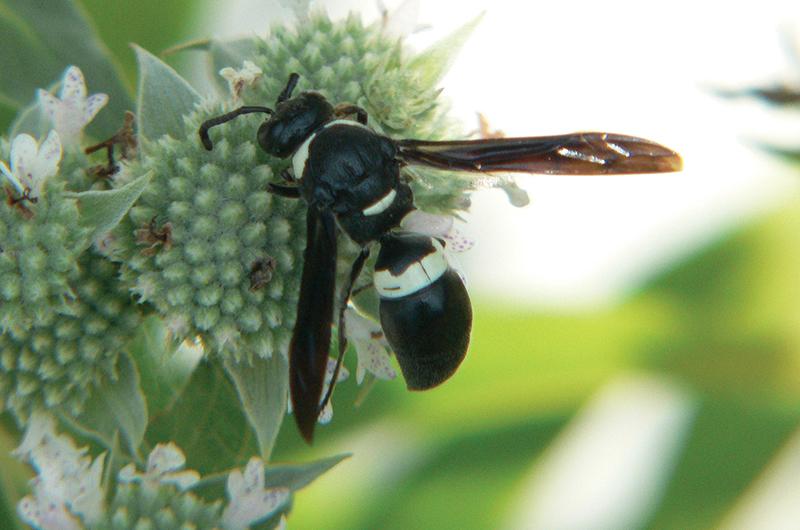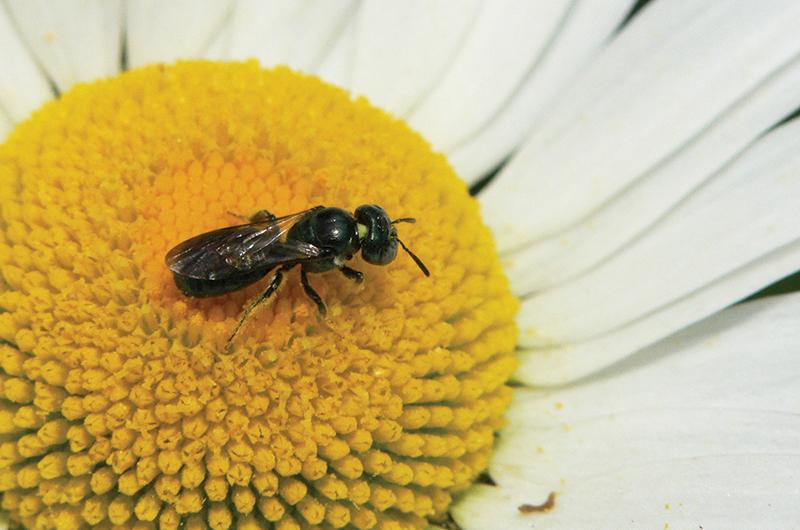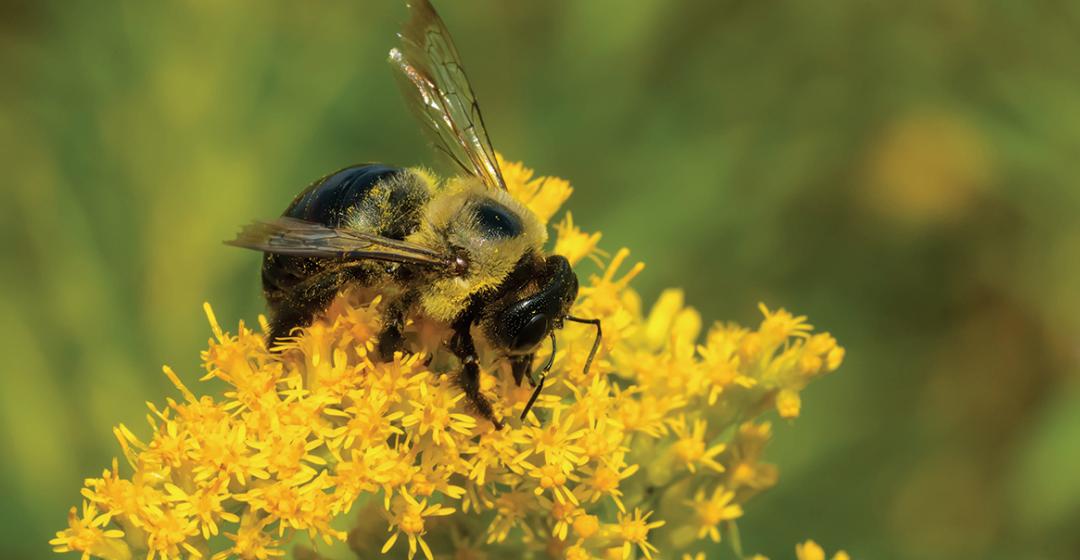The name “carpenter bee” is a bit too kind. Carpenters build things; these bees just make holes in wood. They chew nest tunnels that stretch for inches or even feet inside a suitable branch or board. They are the drill bits of the insect world. And regrettably, wood surfaces of human dwellings provide a frequent target for their efforts. But viewed in a broader context, these bees are both more talented and more useful than one might think.
To be sure, if your house has been perforated by carpenter bees, your irritation is understandable. These are big, powerful insects, roughly an inch long; their burrows exceed a quarter-inch in diameter. The damage they cause is real and can mar trim and siding, or even in extreme cases weaken structural pieces.

Female carpenter bees do the damage. They emerge from hibernation as the weather warms in May at our latitude, and seek appropriate wood for excavation, using their strong mandibles either to extend old nest tunnels or to create new ones. Tunnels typically enter perpendicular to the wood surface but quickly turn aside, following the grain of the wood for easier chewing. Running for inches or even feet inside the wood, tunnels eventually branch into a small network of cells, each of which will receive an egg and a store of pollen. After sealing off the tunnel with a plug of well-chewed wood pulp, the adult female leaves her eggs unattended, senesces, and dies, her work completed.
Upon hatching, members of the new generation feed on the stored pollen as larvae and following a brief dormant stint as pupae emerge as mature bees in late July or August. These new adults stock an existing nest hole (often the one they hatched in) with a supply of pollen to eat, and as cold weather sets in, settle in to overwinter and start the cycle again in spring. The conditions that attract one generation of bees will likewise appeal to the next, so carpenter bees tend to appear (and excavate) in the same places year after year – a habit that lets their damage accrue over time.
Male carpenter bees, meanwhile, don’t chew wood but enthusiastically seek out females with which to mate. Males also defend territories, each selecting a small area (say, one side of a house) that offers the bee an attractive nesting habitat. Rival males engage in aerial duels to determine dominance. This belligerent behavior isn’t limited to other carpenter bees; any moving object, including a human being, can prompt a territorial display. While it’s daunting to have an inch-long bee hovering in front of your face, you needn’t worry. As is the case with all our bees and wasps, the males aren’t equipped with stingers and are perfectly harmless. (Females can sting, but are reluctant to do so; like most bees, these are docile animals.)

One can find carpenter bees in natural habitats on the Vineyard, and presumably these bees found places to nest before the modern building industry took hold here. But most of the carpenter bees I encounter turn up right in our yard, displaying a particular fondness for tunneling into the frames of our skylights and the unpainted two-by-fours that frame our outdoor shower. These choices reflect the insect’s preference for wood type; given their need to chew long and carefully aligned tunnels, carpenter bees prefer to nest in straight-grained softwoods such as fir and spruce. These conifers are not native to the Vineyard and occur only patchily as introduced plants. But they’re the materials of choice for most building projects, with human carpenters choosing them for the same workability that appeals to carpenter bees. Modern building methods, this is to say, have inadvertently created boundless new housing opportunities for Island carpenter bees.
The diligent digging of the bees, in turn, creates opportunities for other insects. Many bees and wasps lay their eggs in tunnels and will use abandoned carpenter bee tunnels to save the work of excavating their own nest sites. Mason bees – powerful pollinators that many gardeners deliberately try to attract with “hotels” made of bundles of straw – are one example. And Monobia quadridens, a type of mason wasp, nests every year in old bee burrows in our outdoor shower. Instead of stocking its nest with pollen, a female Monobia brings in a supply of caterpillars, which she paralyzes with a sting before hauling them back to her nest site as food for her offspring. Such predatory habits are common among wasps, and Monobia and its kin are crucial factors regulating the population size of their prey. Carpenter bees, that is to say, indirectly help control a host of potential pest species. Other insects will enter carpenter bee tunnels in search of leftover pollen or for temporary shelter. Carpenter bee tunnels, in short, furnish a valuable and widely used resource.
Homeowners beleaguered by carpenter bees may get some help from an unexpected quarter, in the form of the large and boldly marked tiger bee fly. Xenox tigrinus, a nest parasite on carpenter bees, locates an active carpenter bee nest and lays its eggs in the bee’s tunnel. When the fly eggs hatch, the resulting larvae – “maggots” is such a harsh word! – locate the bee eggs or larvae and feed on them until reaching maturity.

The catch, from the human perspective, is that Xenox does nothing to prevent carpenter bees from chewing into your window frame in the first place. Indeed, the fly is waiting for the burrow to be completed, since that’s when the bee larvae become available for consumption. Also, such parasitic relationships tend to have built-in limitations. If the nest parasite gets too successful, its host
species becomes uncommon, reducing the number of nests available to parasitize. That in turn reduces the numbers of the parasite – which allows the population of the parasite’s host to bounce promptly back to its former level. But although it will never extirpate their host, the tiger bee fly surely puts a crimp in the reproductive success of the carpenter bee, tending to keep its numbers within a fairly steady and reasonable range.
If you feel that a more direct defense against carpenter bees is called for, you have several options. Not necessarily the easiest method, but most effective and most polite toward the bees, is making sure no untreated softwood is available. Carpenter bees rarely bore into painted wood, and even a single application of stain is said to discourage them. Synthetic materials used for house trim, of course, are immune to carpenter bee damage. If you discover a tunnel that has been started, you can try plugging it with wood whittled to size, or even with steel wool. This may discourage the bee (or it may just make her try again a few inches away). Likewise, swatting a female carpenter bee may buy you a respite, but the odds are good another female will come along and resume the excavation.
Though I’ve been using the term “carpenter bee” in a way that suggests there is only one kind, it’s really a generic term, referring to the subfamily Xylocopinae, a subset of the family Apidae, which also includes the familiar honeybee and bumblebee. Some thousand or more carpenter bee species chew houses around the world; North America, mercifully, hosts only about thirty species. Our most destructive ones are in the genus Xylocopa, and of the nine North American species in that genus, only one, Xylocopa virginica, occurs in the Northeast. That’s our culprit! One of our largest bees, it resembles a bumblebee in its black-and-yellow color scheme, but can be distinguished by its nearly hairless face and abdomen.

A second, more benign genus of carpenter bees also occurs in our region. Much smaller than Xylocopa and arguably more attractive, at least four greenish, dully iridescent members of the genus Ceratina figure among the Vineyard’s insect fauna. Among our surprising diversity of green or greenish bees, Ceratina can be recognized with practice by its distinctively blunt-tipped, club-shaped abdomen. Smaller (less than half an inch in length) and less powerful than Xylocopa, Ceratina unsurprisingly seeks out more tender substrate for nesting. A typical site would be inside a dead stem of a large wildflower where the bee can hollow out the pith to form a snug shelter for overwintering and then, the following spring, laying eggs. Ceratina is easy to overlook but appears to be quite common on the Vineyard, and because members of this genus aren’t robust enough to tunnel into solid wood, these elegant bees pose no threat to your siding.
As you’d expect from their resemblance and close relationship to bumblebees, adult Xylocopa carpenter bees frequently visit flowers. Adults of both types of bee are fueled largely by nectar, a sugar-rich liquid produced by flowers as a bribe to attract pollinators. The bees access nectar with their (often surprisingly long) tongues. And both bumble- and carpenter bees gather pollen, which, transported back into the nest, feeds their offspring once hatched. While some bees show strong preferences in their nectar sources, bumblebees and carpenter bees are quite ecumenical, visiting nearly anything that is in bloom. Blueberry flowers are a favorite in early spring; later on, carpenter bees happily frequent milkweed flowers, as well as cultivated flowers such as coneflower and phlox.
Bumblebees and carpenter bees differ in their approaches to the art of flower visitation, however, and some of these differences turn out to be of considerable ecological importance. A bumblebee collects pollen on its leg and body hairs as it visits flowers, then grooms the sticky pollen grains down onto a clump of specially evolved bristles, called “scopa,” on its hind legs. Often you can see these “pollen baskets” (“corbiculae” to entomologists) loaded with yellow blobs of pollen grains. This specialized feature is absent on a carpenter bee, which instead transports pollen in a more dispersed manner on bristles that cover the hind legs.

Both bumblebees and carpenter bees function as pollinators, transporting pollen grains from the male parts of one flower to the female parts of another as they forage. With their more efficient pollen collection methods, though, bumblebees may actually be less effective pollinators than their relatives, at least for large, flat flowers such as apple blossoms. Pollen that ends up back in the bee nest does not help plant fertility, so the less tidy technique of carpenter bees may translate into more lost pollen and hence more fertilization assistance for plants.
Bumblebees, with their long tongues, can readily extract nectar from small or tubular flowers. Carpenter bees, whose tongues are shorter, employ a different method for drinking nectar. Using their mandibles, they snip a small hole in the base of the flower, taking a shortcut to the reserve of nectar that resides there. Because they never come in contact with the flower’s stamens when they forage like this, such “nectar robbing” behavior fails to perform any pollination at all. On the Phlox paniculata flowers in our Oak Bluffs yard, a high percentage of flower calyxes end up perforated or snipped off altogether by carpenter bees, hastening the end of the bloom season for this otherwise rugged ornamental. And in spring, many of our blueberry blossoms end up with holes cut into their bases, a sign of carpenter bees shirking their pollination duties.
All in all, though, the foraging of these large and active bees moves a lot of pollen around. Indeed, researchers are exploring the notion of building artificial populations of carpenter bees (as beekeepers do with the Eurasian honeybee) to support pollination in agricultural settings. It is only in their nesting habits that carpenter bees cause problems. For this reason, if a bee tunnel appears in some nonessential piece of wood, you might just accept the damage, knowing that you’re providing a home for a valuable insect.
The complex relationship between humans and carpenter bees mirrors the tension of our entire relationship with nature. Human activity encroaches relentlessly on natural environments, with house lots and roads reducing the amount of habitat for wildlife and fragmenting what remains. The result is pressure on wildlife to find new opportunities for food or shelter amid the newly humanized environment – and nobody should be surprised when wildlife seizes those opportunities. Here on the Vineyard, we’ve replaced vast tracts of wooded carpenter bee habitat with human housing, and in doing so, have erected alternative nest sites that the bees may actually prefer to natural ones. The result may be a chronic annoyance for the homeowner. But please, remember who was here first, and who changed the landscape.




 3 comments
3 comments
Comments (3)